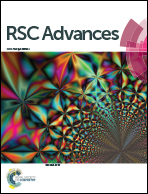Steric and electronic control over the structural diversity of N-(n-pyridinyl) diphenylphosphinic amides (n = 2 and 4) as difunctional ligands in triphenyltin(iv) adducts†
Abstract
Two triphenyltin(IV) adducts of difunctional ligands, N-(n-pyridinyl) diphenylphosphinic amide (n = 2 and 4), have been synthesized and characterized by 1H, 31P, 119Sn NMR and IR spectroscopy. The spectroscopic properties of the complexes were compared with those of corresponding ligands. The crystal structures of the complexes were determined by X-ray crystallography, which reveals a trigonal bipyramidal geometry surrounding the tin(IV). Both of the ligands function in an ambidentate mode, ligating through either the O or N atom. The experimental and theoretical (DFT) studies show that the Sn(IV) interacts more strongly with the N-pyridine atom than the P![[double bond, length as m-dash]](https://www.rsc.org/images/entities/char_e001.gif) O functional group. Furthermore, DFT calculations, at the B3LYP level, have been carried out to determine the deeper reasons for the adopted bonding mode in the complexes. The influence of the ligand structure on the coordination behaviour and the contribution of hydrogen bonding to the stability of the resulting complexes were elucidated. The results indicate that the intermolecular hydrogen bonds have an important role in the molecular structures and supramolecular associations of the organotin(IV) compounds.
O functional group. Furthermore, DFT calculations, at the B3LYP level, have been carried out to determine the deeper reasons for the adopted bonding mode in the complexes. The influence of the ligand structure on the coordination behaviour and the contribution of hydrogen bonding to the stability of the resulting complexes were elucidated. The results indicate that the intermolecular hydrogen bonds have an important role in the molecular structures and supramolecular associations of the organotin(IV) compounds.


 Please wait while we load your content...
Please wait while we load your content...